Bamboos have a tree-like habit, a well-developed rhizome system, woody, and hollow culms, branching patterns, petiolate leaves, and specialized sheathing organs. Identifying bamboos up to species level is also determined with the help of different characteristics in rhizome such as scale leaves, nodes, and internodes, presence of air canals, the occurrence of root length, rhizome length, etc.
Rhizome
It is well-developed, subterranean stems highly branched from which generate the roots and aerial culms from nodes. The individual axes of the rhizome system are known as rhizome segments. Rhizome stores food and also functions in vegetative reproduction. It consists of two parts, the rhizome neck and the rhizome proper. The rhizome neck may be short or sometimes elongated.
There are different types of rhizomes: -
- Pachymorph (sympodial rhizome): Solid type, usually short and thick curved and sub-fusiform structures with sympodial branching. Bamboos with this type of rhizome are clump-forming. In sympodial rhizome, internodes are broader than long, solid and lateral buds solitary. Roots originate from the lower portion. Pachymorph can be classified into two categories, short-necked and long-necked based on the length of the rhizome neck. The short-necked pachymorph rhizomes show a caespitose clump habit and in bamboos, with long-necked pachymorph rhizomes the culms grow in a diffuse manner. Commonly, the genera like Bambusa, Dendrocalamus, Arundinaria, Ochlandra, oxytenanthera etc., represent pachymorph rhizome.
- Leptomorph (monopodial rhizome): Thin with monopodial and its lateral buds give rise to new culms directly, and it is long and slender, diameter is usually less than the culms originating from it. It may be cylindrical, or subcylindrical, the internodes are longer than broad, relatively uniform in length, typically hollow, and rarely solid. Bamboos with this type of rhizome continue their horizontal growth without forming clumps and culms that develop from the lateral buds. Some of the lateral buds give rise to rhizomes also.
- Metamorph: This is with leptomorph rhizomes and with both sympodial and monopodial branching.
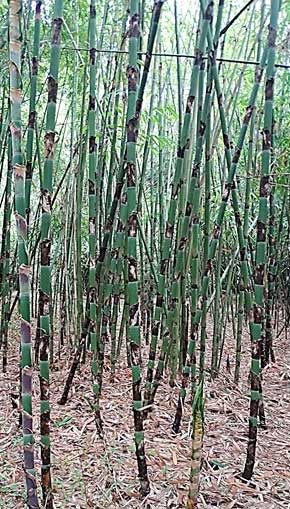
Bamboo with monopodial rhizomes
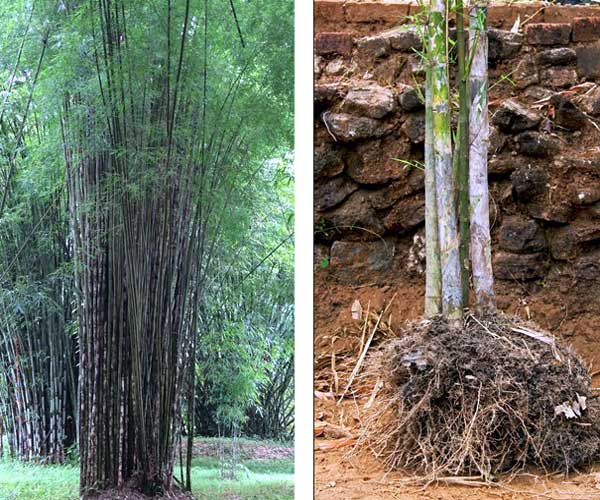
Bamboo with sympodial rhizomes
Young shoots
Young shoot is the new aerial stem arising from the apical bud of a pachymorph rhizome or from the lateral bud of a leptomorph rhizome. It has short, soft internodes protected by culm sheaths attached to the alternate sides of successive nodes. Each shoot is a highly condensed series of nodes and internodes. These shoots elongate rapidly to become a mature culm. During the elongation of the internodes of the culm shoots, the culm sheath and its parts become visible and clear. Bamboo identification can easily be done using the morphological features of young shoots. The colour and presence of hairs, presence of auricles, ligules, and oral setae will vary from species to species. In some of the species, the tender shoots are edible also. The edible bamboo shoots are low in fat content and high in potassium, carbohydrate, dietary fibres, Vitamins, and active materials and are consumed in raw, canned, boiled, marinated, fermented, frozen, liquid and medicinal forms.
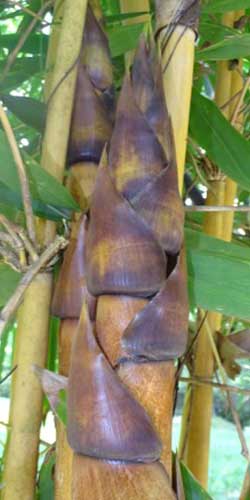
Schizostachyum brachycladum
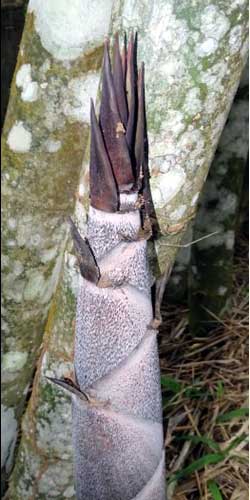
Dendrocalamus giganteus
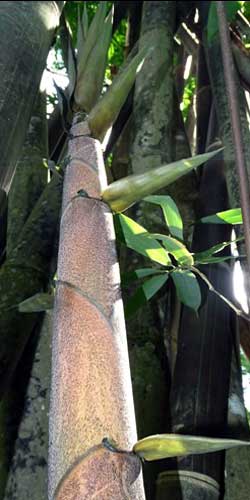
Gigantochloa atroviolacea
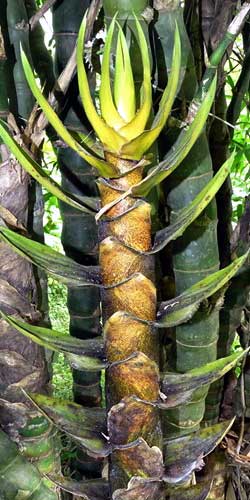
Bambusa wamin
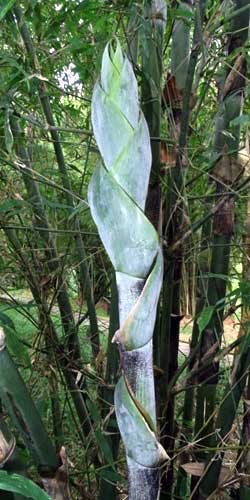
Bambusa tulda
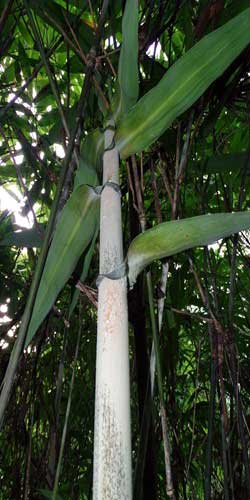
Oxytenanthera bourdillonii
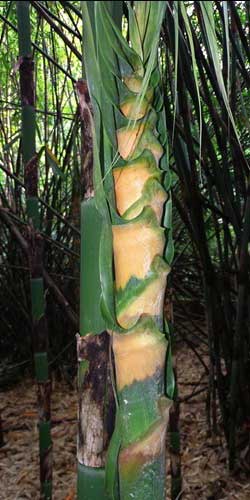
Melocanna baccifera
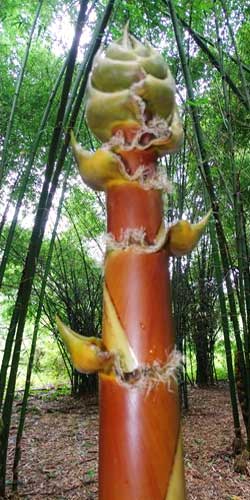
Cephalostachyum pergracile
Culm
It is the aerial vegetative parts arising from the rhizomes. The culms are apical in pachymorph rhizome and lateral in leptomorph rhizomes. Culms are segmented and the nodes and internodes are distinct. Most bamboo culms are cylindrical and hollow in nature but in some bamboos, the culms are almost solid or completely solid. Culm habits vary from erect, erect with drooping or pendulous tips, broadly arched, scrambling, climbing, and strongly zigzag. The nodal region of the bamboo encloses a branch bud and the culm sheaths arise from here. The nodal line or sheath scar is the basal portion of each node and the scar is left after the culm leaf falls off. In some species, the presence of a supra-nodal ridge is also prominent. The presence of down curved root thorns is another interesting feature noted in some species.
Generally, the internodes are cylindrical and they may also vary to quadrangular shape, with short and swollen forms or covered with a white powdery mass/wax. There is great variation among bamboo species on the total number of internodes on the tallest culm, length of internodes; combination and pattern of colours (green, bluish-green, and with or without white, yellow or green stripes), form and texture of the surface, presence of any channel or groove; and the presence and type of pubescence, etc., and thereby it is morphologically important for the identification of bamboo species.
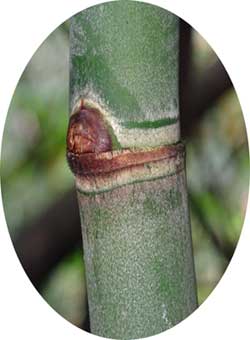
Node with prophyllate bud
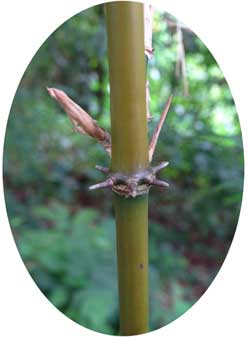
Node with root thrones
Culm sheath
Culm sheaths are modified leaves that cover and protect the developing internodes of young shoots and young culms. Depending upon the species, when the culms mature culm sheath may be firmly attached or may not be persistent. It consists of an expanded sheath, a narrow blade, and a ‘ligule’; in some bamboo species, well-developed auricles and oral setae may be present. The auricles are nothing but lobe-like or rim-like structures occurring on each side of the base of the culm sheath blade. The ligule is present on the inner side of the sheath, where the blade joins, and in some species, the presence of an outer ligule is also noted. The culm leaf blade is highly variable with respect to its size, position, and morphology. They can be erect spreading or reflexed. They also vary in their shapes. As the morphological features of the culm sheaths are species-specific, it is used for the identification of bamboos at the species level.
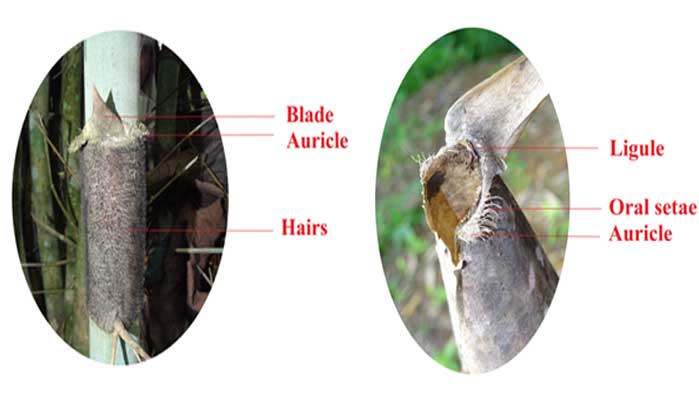
Node with prophyllate bud
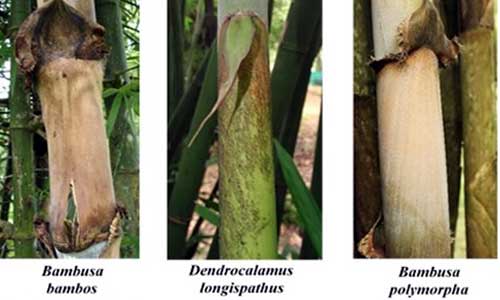
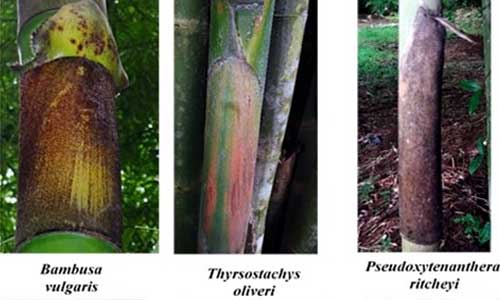
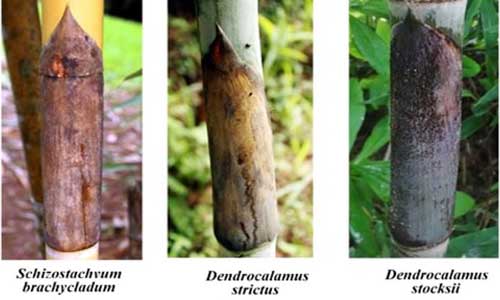
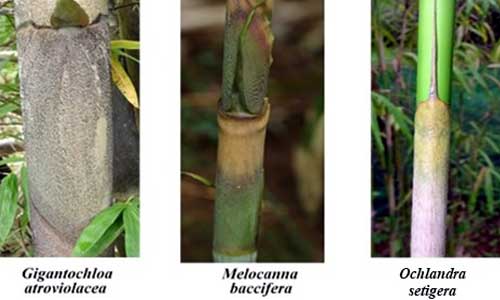
Prophyll
The bud is entirely covered by a scale-like, membranous or thickened structure called a bud scale or prophyll. It is a sheath, which occurs at the base of the node of each vegetative branch, representing the first leaf of that branch. It is a one or two-keeled structure, which encloses and protects the branch primordia. The back of the prophyll closely adheres to the axis from which the branch emerges. The margins of the prophyll cover the branch primordia. The morphology of the prophyll especially the location of the bud on the node, its shape, and numbers, and whether closed at the back and/or the front varies in different species and therefore, is considered taxonomically very important.
Branches
When the culm has reached its full height; the lateral buds begin to grow and form branches. Generally, a typical form of branch complement appears on mid-culm nodes with more branches above and fewer below. Depending upon the presence and number of lateral branches arising from a primary branch, these are classified as ‘single branching’ (with a solitary primary branch at nodes, ‘double branching’ (with two branches at the node, 'triple branching’ (with three branches at the nodes, or ‘multiple branching’ (with more than three branches at the nodes. In most bamboo, the buds at the lower nodes usually remain dormant. But, in Bambusa and Dendrocalamus the branches develop from the basal culm nodes as well. In Bambusa bambos these form a thicket around the base of the culm and are spiny. In many bamboo genera, the primary branch emerges and remains strongly dominant. The primary axis remains dormant in the bud stage and later produces a new culm or long whip-like branch.
Leaves
The leaf sheath and the blade are basically two parts of the leaves. The leaves have a relatively small sheath and an expanded, well-developed leaf blade. Sheaths are attached to the nodal part and support the leaf blade. Veins are distinctly seen on the outer surface. The inner surface is smooth and shining. The sheaths also bear outer and inner ligules. They are present in the region of attachment of the petiole and sheath. The sheaths bear auricles and bristles. The auricles and bristles are clear and prominent in young leaves. Leaf size varies from species to species. Venation is parallel.
Inflorescence
Bamboos have a compound inflorescence, which consists of numerous flowers. The inflorescence is an aggregation of spikelets that may appear on leafy branches or as gigantic panicles covering the whole culm. There are four basic types, spicate, racemose, paniculata, and capitate. In spicate inflorescence, the stalk of the spikelet is highly reduced or absent. The racemose inflorescence has spikelets with stalks. In paniculate inflorescence, the spikelet is stalked and shows more than one order of branching. The capitate inflorescence is similar to paniculate, but the internodes are very short, forming dense, globose heads.
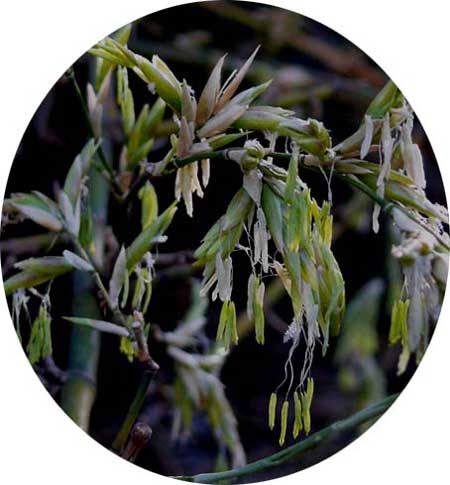
Bamboo Inflorescence - Dense, globose heads
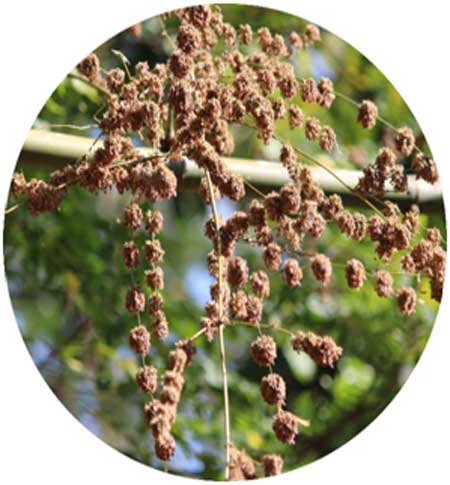
Bamboo Inflorescence - Panicle
Flowering
Bamboos are classified into three types based on the flowering cycle.
- Annual flowering: Also known as continuous flowering. Species that flower every year and do not die. eg. Ochlandra scriptoria, Kuruna wightiana
- Gregarious flowering: Also called periodic flowering. The whole clump flowers in an extensive area and dies after the seed is set. The flowering may continue for two to three years in an area or in the same clump.
- Sporadic or irregular flowering: occurs in parts of one clump (in one or two culms) or in isolated clumps (in one or two in an area).
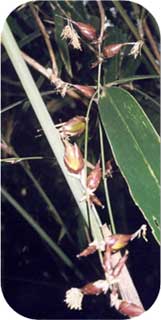
Fruit
Fruit is generally caryopsis, which is indehiscent and one-seeded and has a thick and fleshy pericarp in some species. Based on the morphology fruit is classified into three categories.
- Caryopsis: The pericarp is thin, soft, and membranous, and adheres to the seed coat. The fruit has an apparent ventral suture which is nearly as long as the whole fruit. An orbiculate navel is located at the fruit base. e.g.Bambusa, Chimonobambusa, Gigantochloa, Phyllostachys,Thyrsostachys.
- Glans: It has a hard, smooth, crustaceous pericarp, separated from the seed coat. The fruit has no ventral suture and navel. e.g. Dendrocalamus, Schizostachyum.
- Bacca: It has a thick fleshy pericarp, separated from the seed coat. Melocanna and Ochlandra species are examples of these types of fruits.
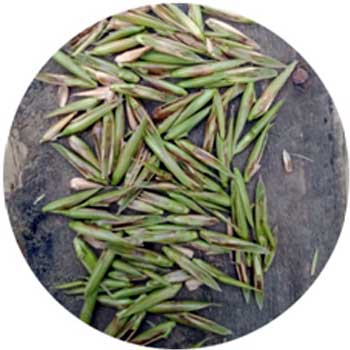
Caryopsis
(Bambusa tulda)
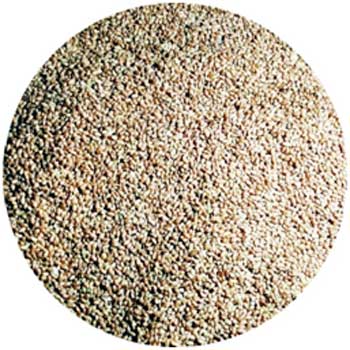
Glans
(D. longispathus)
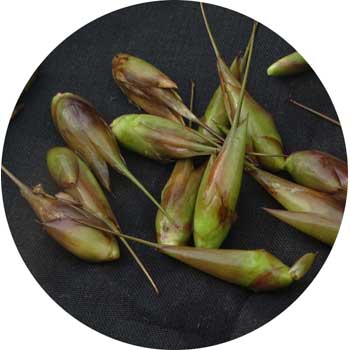
Bacca
(Ochlandra talbotii)
Classifications of bamboos
Based on morphological appearance
- Woody Bamboos: These are perennial, small to large, erect to scandent, or climbing plants with well-developed woody rhizomes and culms. Rhizomes are sympodial or monopodial in appearance. The culms generally are lignified and greater than one meter.
- Herbaceous bamboos: These are small less than one meter tall with herbaceous culms, and poorly developed rhizomes with limited aerial branching. Culm leaves are usually absent. Roots are more prominent than rhizomes. New vegetative shoot bear foliage leaves directly, culm leaves absent and vegetative branching absent or simple. Leaves lack an outer ligule. The important genera include Olyra (24 species), Parodiolyra (5 species), Piresia (5 species), Piresiella (1 species), Raddia (9 species), Raddiella (8 species) etc., The members typically occur in rainforests or less commonly in lower montane forests up to 1,500 m in elevation.
Based on Habit
- Tree forms: These forms include tall arborescent woody bamboos with short or long-necked sympodial rhizomes; 8 to 10m tall erect culm with large or medium-sized culms 4 to 30cm in diameter with thin or thick-walled culms. The majority of the genera in Bambusinae (Bambusa, Dendrocalamus, Gigantochloa, Oxytenanthera, Thyrsostachys etc.), Guaduinae (Guadua, Olmeca, Otatea, etc.) belong to this group. View some examples from our bamboo database: Dendrocalamus membranaceus, Bambusa polymorpha, Gigantochloa atroviolacea
- Reeds: Reed-bamboo medium-sized gregarious bamboos with sympodial short-necked erect or semi-straggling, thin-walled culms of 3 to 10m tall and 1.5 to 6cm in diameter growing in large extensive areas. The extensive natural population of these thin-walled bamboos forms the pure patch and is called reed breaks. The genera like Ochlandra, Pseudostachyum, etc. possess this growth form. View some reeds from our bamboo database: Pseudostachyum polymorphum, Ochlandra setigera , Gigantochloa atroviolacea.
- Stragglers: Stragglers are medium-sized bamboos with thin walls and suberect culms; culms 3 to 8m tall. The tip of the culm arching and sometimes droops down or some climb onto the adjacent trees. The genera like Schizostachyum, Teinostachyum belong to this group. Eg: Ochlandra wightii
- Climbers: These are tall arborescent bamboos with long or short-necked pachymorph rhizomes and prominent nodes. The culms after attaining a certain length become scandent and approach for support from neighbouring plants. The genus Dinochloa belongs to this group. Eg. Dinochloa andamanica
- Shrub: These are erect and short bamboos with short or long-necked pachymorph rhizomes. The culms are 1 to 4m tall (rarely up to 7m) with thin-walled culms. The bamboos of the subtribe Arundinarrinae belong to this group.
